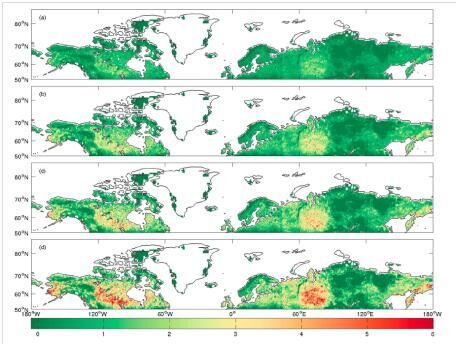作 者:Zhu, XD; Zhuang, QL影响因子:3.395
刊物名称:JOURNAL OF GEOPHYSICAL RESEARCH
出版年份:2016
卷:121 页码:5736-5748
Warming-induced changes in structures and functions of northern terrestrial ecosystems (NTEs), including their regulation on terrestrial biogeochemistry and surface energy balance, may exert positive or negative feedback to the climate system. However, the relative importance among these biogeochemical and biogeophysical feedback is not well understood. Here we use a terrestrial ecosystem model to quantify spatially explicit ecosystem-climate feedback over NTEs (north of 50ᵒ N) under four climate change scenarios from 2010 to 2100, including biogeochemical feedback from climate-induced changes in net CH4exchanges (NME) and net CO2exchanges (NCE) and biogeophysical feedback from changes in surface energy partitioning associated with snow cover and vegetation biomass dynamics. Our results indicate that (1) biogeochemical and biogeophysical feedback are attributed more to the changes in NME and snow cover dynamics, respectively; (2) net biogeophysical feedback is much larger than net biogeochemical feedback; (3) NTEs will cause a net positive radiative forcing of 0.04-0.26 Wm-2between 2010 and 2100. Our findings support the notion that NTEs will exert positive net climate feedback; however, our estimation of positive net biogeochemical feedback including NME- and NCE-induced effects is contrary to previous studies showing negative net biogeochemical feedback including NCE-induced effect only. This study highlights the importance of NME-induced biogeochemical effect in regulating ecosystem-climate feedback in NTEs and implies that previous studies without considering NME induced effect might have underestimated the intensity of total terrestrial feedback to the climate system.

Fig. 1.Change in decadal mean annual net CH4 exchanges (NME, g CH4m-2 yr-1) between the 2010s and 2090s NME2090s-NME2010sover northern terrestrial ecosystems (north of 50°N), under four climate change scenarios: (a) RCP2.6, (b) RCP4.5, (c) RCP6.0, and (d) RCP8.5. Positive values indicate stronger sources or weaker sinks, and negative values indicate stronger sinks or weaker sources.

